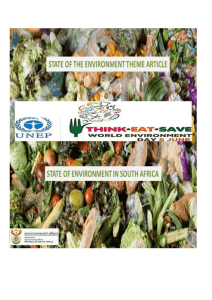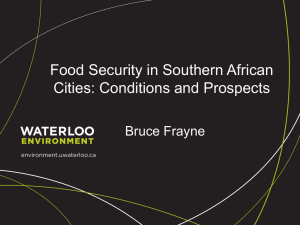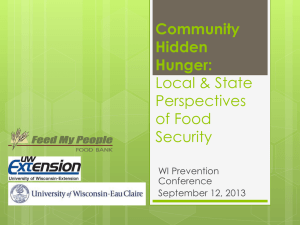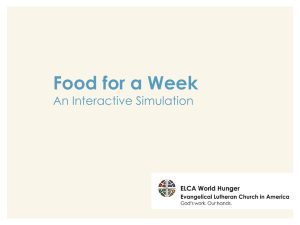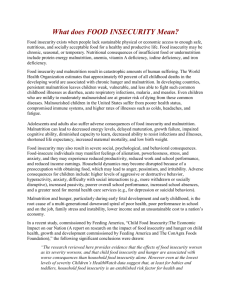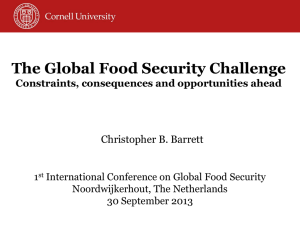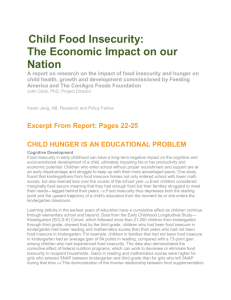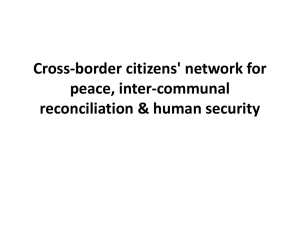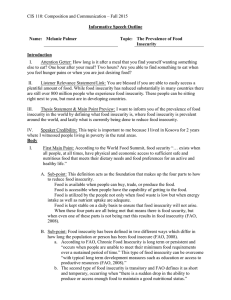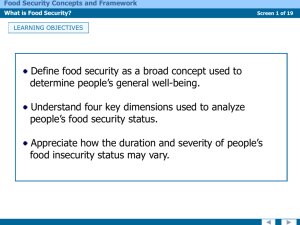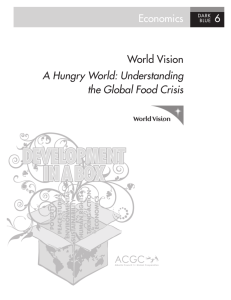An Introduction to the Basic Concepts of Food Security
advertisement
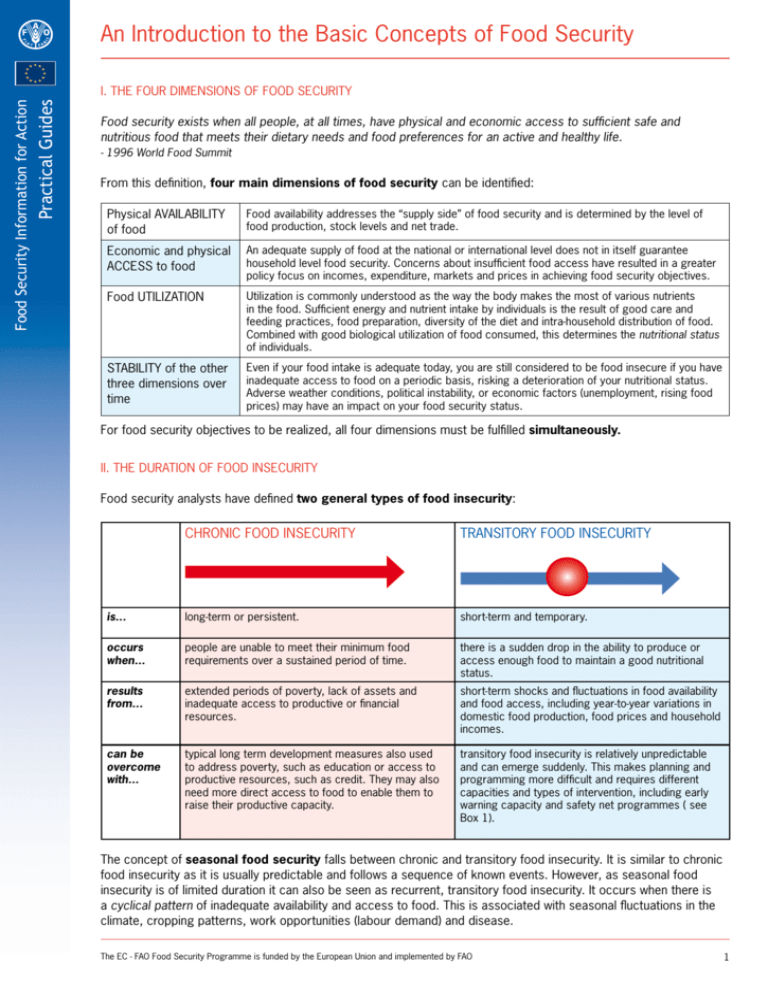
An Introduction to the Basic Concepts of Food Security Practical Guides Food Security Information for Action I. THE FOUR DIMENSIONS OF FOOD SECURITY Food security exists when all people, at all times, have physical and economic access to sufficient safe and nutritious food that meets their dietary needs and food preferences for an active and healthy life. - 1996 World Food Summit From this definition, four main dimensions of food security can be identified: Physical AVAILABILITY of food Food availability addresses the “supply side” of food security and is determined by the level of food production, stock levels and net trade. Economic and physical ACCESS to food An adequate supply of food at the national or international level does not in itself guarantee household level food security. Concerns about insufficient food access have resulted in a greater policy focus on incomes, expenditure, markets and prices in achieving food security objectives. Food UTILIZATION Utilization is commonly understood as the way the body makes the most of various nutrients in the food. Sufficient energy and nutrient intake by individuals is the result of good care and feeding practices, food preparation, diversity of the diet and intra-household distribution of food. Combined with good biological utilization of food consumed, this determines the nutritional status of individuals. STABILITY of the other three dimensions over time Even if your food intake is adequate today, you are still considered to be food insecure if you have inadequate access to food on a periodic basis, risking a deterioration of your nutritional status. Adverse weather conditions, political instability, or economic factors (unemployment, rising food prices) may have an impact on your food security status. For food security objectives to be realized, all four dimensions must be fulfilled simultaneously. II. THE DURATION OF FOOD INSECURITY Food security analysts have defined two general types of food insecurity: CHRONIC FOOD INSECURITY TRANSITORY FOOD INSECURITY is... long-term or persistent. short-term and temporary. occurs when... people are unable to meet their minimum food requirements over a sustained period of time. there is a sudden drop in the ability to produce or access enough food to maintain a good nutritional status. results from... extended periods of poverty, lack of assets and inadequate access to productive or financial resources. short-term shocks and fluctuations in food availability and food access, including year-to-year variations in domestic food production, food prices and household incomes. can be overcome with... typical long term development measures also used to address poverty, such as education or access to productive resources, such as credit. They may also need more direct access to food to enable them to raise their productive capacity. transitory food insecurity is relatively unpredictable and can emerge suddenly. This makes planning and programming more difficult and requires different capacities and types of intervention, including early warning capacity and safety net programmes ( see Box 1). The concept of seasonal food security falls between chronic and transitory food insecurity. It is similar to chronic food insecurity as it is usually predictable and follows a sequence of known events. However, as seasonal food insecurity is of limited duration it can also be seen as recurrent, transitory food insecurity. It occurs when there is a cyclical pattern of inadequate availability and access to food. This is associated with seasonal fluctuations in the climate, cropping patterns, work opportunities (labour demand) and disease. The EC - FAO Food Security Programme is funded by the European Union and implemented by FAO 1 An Introduction to the Basic Concepts of Food Security Practical Guides Food Security Information for Action Box 1. What are Safety Nets? Measures to enhance direct access to food are more likely to be beneficial if these are embedded in more general social safety net programmes. Safety nets include income transfers for those chronically unable to work—because of age or handicaps—and for those temporarily affected by natural disasters or economic recession. The severity of undernourishment indicates, for the food deprived, the extent to which dietary energy consumption falls below the pre-determined threshold. The Integrated Food Security Phase Classification (IPC) The IPC is a classification system for food security crises based on a range of livelihood needs: Options include: IPC Phase Classification Indicators • Targeted direct feeding programmes. These include school meals; feeding of expectant and nursing mothers as well as children under five through primary health centres, soup kitchens and special canteens. Generally food secure • Food-for-work programmes. Food-for-work programmes provide support to households while developing useful infrastructure such as small-scale irrigation, rural roads, buildings for rural health centres and schools. Humanitarian emergency - Crude Mortality Rate - Malnutrition prevalence - Food Access/ Availability - Dietary Diversity - Water Access/Availability - Coping strategies - Livelihood Assets Chronically food insecure Acute food and livelihood crisis Famine / humanitarian catastrophe See www.ipcinfo.org for more information • Income-transfer programmes. These can be in cash or in kind, including food stamps, subsidized rations and other targeted measures for poor households. Stamoulis, K. and Zezza, A. 2003. A Conceptual Framework for National Agricultural, Rural Development, and Food Security Strategies and Policies. ESA Working Paper No. 03-17, November 2003. Agricultural and Development Economics Division, FAO, Rome. www. fao.org/documents/show_cdr.asp?url_file=/docrep/007/ae050e/ ae050e00.htm III. THE SEVERITY OF FOOD INSECURITY When analyzing food insecurity, it is not enough to know the duration of the problem that people are experiencing, but also how intense or severe the impact of the identified problem is on the overall food security and nutrition status. This knowledge will influence the nature, extent and urgency of the assistance needed by affected population groups. Different ‘scales’ or ‘phases’ to ‘grade’ or ‘classify’ food security have been developed by food security analysts using different indicators and cut-off points or ‘benchmarks’. Examples include: IV. VULNERABILITY The dynamic nature of food security is implicit when we talk about people who are vulnerable to experiencing food insecurity in the future. Vulnerability is defined in terms of the following three critical dimensions: 1. vulnerability to an outcome; 2. from a variety of risk factors; 3. because of an inability to manage those risks. Indeed, a person can be vulnerable to hunger even if he or she is not actually hungry at a given point in time. Vulnerability analysis suggests two main intervention options: 1. Reduce the degree of exposure to the hazard; 2. Increase the ability to cope. By accounting for vulnerability, food security policies and programs broaden their efforts from addressing current constraints to food consumption, to include actions that also address future threats to food security. Measuring the Severity of Undernourishment The measure for hunger compiled by FAO, defined as undernourishment, refers to the proportion of the population whose dietary energy consumption is less than a pre-determined threshold. This threshold is country specific and is measured in terms of the number of kilocalories required to conduct sedentary or light activities. The undernourished are also referred to as suffering from food deprivation. Box 2. Analyzing the Risk of Becoming Food Insecure For example, we may be interested in analyzing the risk of becoming food insecure as a result of a flood. If a household lives outside a flood plain then the exposure to flooding is low and therefore the risk of a flood causing the household to become food insecure is 2 An Introduction to the Basic Concepts of Food Security Practical Guides Food Security Information for Action low (unless their crops are in the valley!). However, if they live on the flood plain, but they have the ability to cope with the hazard, for example by being very mobile, and being able to move their animals and/or food crops to safety, then the risk may still be low. V. HUNGER, MALNUTRITION AND POVERTY It is important to understand how these three concepts are related to food insecurity. Hunger is usually understood as an uncomfortable or painful sensation caused by insufficient food energy consumption. Scientifically, hunger is referred to as food deprivation. deprivation that relate to human capabilities including consumption and food security, health, education, rights, voice, security, dignity and decent work.” - Organisation for Economic Co-operation and Development (OECD) It is argued that a strategy for attacking poverty in conjunction with policies to ensure food security offers the best hope of swiftly reducing mass poverty and hunger. However, recent studies show that economic growth alone will not take care of the problem of food security. What is needed is a combination of: - income growth; supported by - direct nutrition interventions; and - investment in health, water and education. FIND OUT MORE: Simply put, all hungry people are food insecure, but not all food insecure people are hungry, as there are other causes of food insecurity, including those due to poor intake of micro-nutrients. E-learning Malnutrition results from deficiencies, excesses or Further Reading imbalances in the consumption of macro- and/or micronutrients. Malnutrition may be an outcome of food insecurity, or it may relate to non-food factors, such as: - inadequate care practices for children, - insufficient health services; and - an unhealthy environment. While poverty is undoubtedly a cause of hunger, lack of adequate and proper nutrition itself is an underlying cause of poverty. A current and widely used definition of poverty is: “Poverty encompasses different dimensions of Figure 1: Food insecurity, malnutrition and poverty are deeply interrelated phenomena Poverty These guidelines are taken from the e-learning course “Food Security Concepts and Frameworks” available at: www.foodsec.org/dl Devereux, S. 2006 Distinguishing between chronic and transitory food insecurity in emergency needs assessments. SENAC. WFP. Rome. Dilley M. and Boudreau T.E. Coming to terms with vulnerability: a critique of the food security definition. Food Policy, Volume 26, Number 3, June 2001 , pp. 229-247(19) FAO. 2003. Focus on Food Insecurity and Vulnerability – A review of the UN System Common Country Assessments and World Bank Poverty Reduction Strategy Papers. FIVIMS Secretariat and Wageningen University and Research Centre: www.fao.org/DOCREP/006/Y5095E/Y5095E00.htm Sen, A.K. 1981. Poverty and Famines: An Essay on Entitlements and Deprivation. Oxford. Clarendon Press. Stamoulis, K. and Zezza, A. 2003. A Conceptual Framework for National Agricultural, Rural Development, and Food Security Strategies and Policies. ESA Working Paper No. 03-17, November 2003. Agricultural and Development Economics Division, FAO, Rome. www.fao.org/documents/show_cdr. asp?url_file=/docrep/007/ae050e/ae050e00.htm WFP.2005. Emergency Food Security Assessment Handbook. http://www.wfp.org/operations/emergency_needs/EFSA_ section1.pdf Low productivity Food insecurity, hunger and malnutrition This document is available online at: www.foodsec.org/docs/concepts_guide.pdf For more resources see: http://www.foodsec.org/pubs.htm Poor physical and cognitive development © FAO 2008 Published by the EC - FAO Food Security Programme website: www.foodsec.org e-mail: information-for-action@fao.org 3
